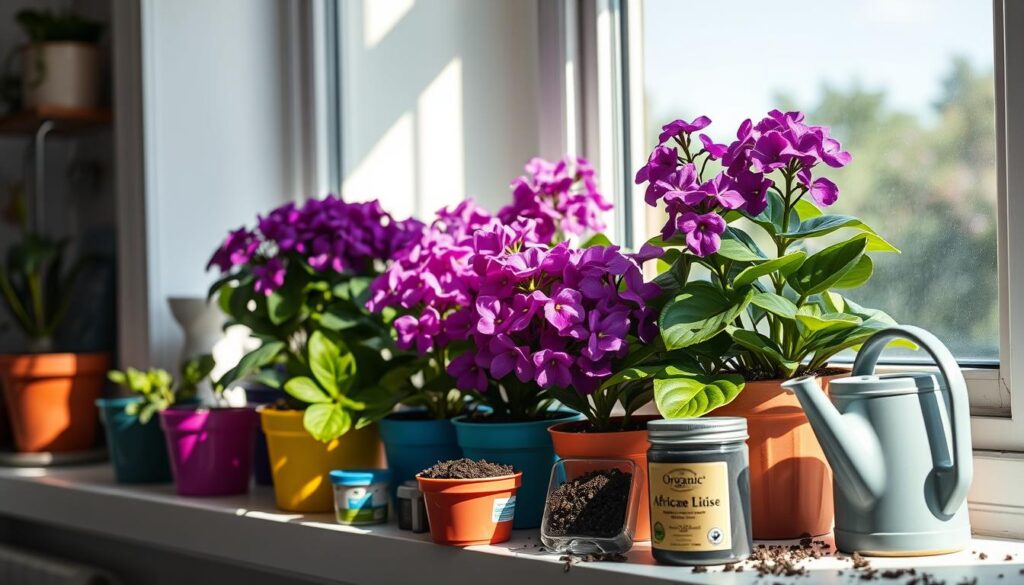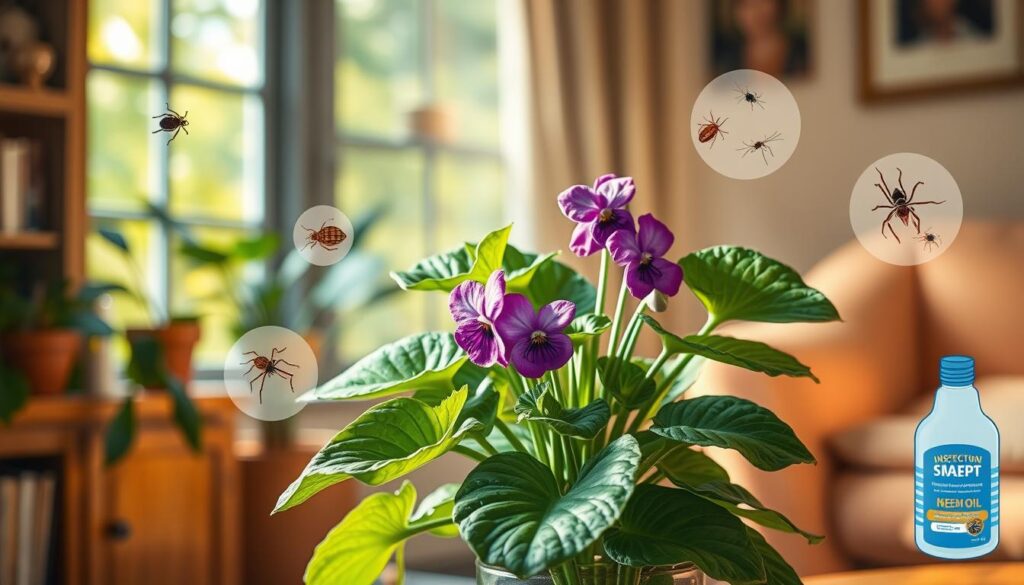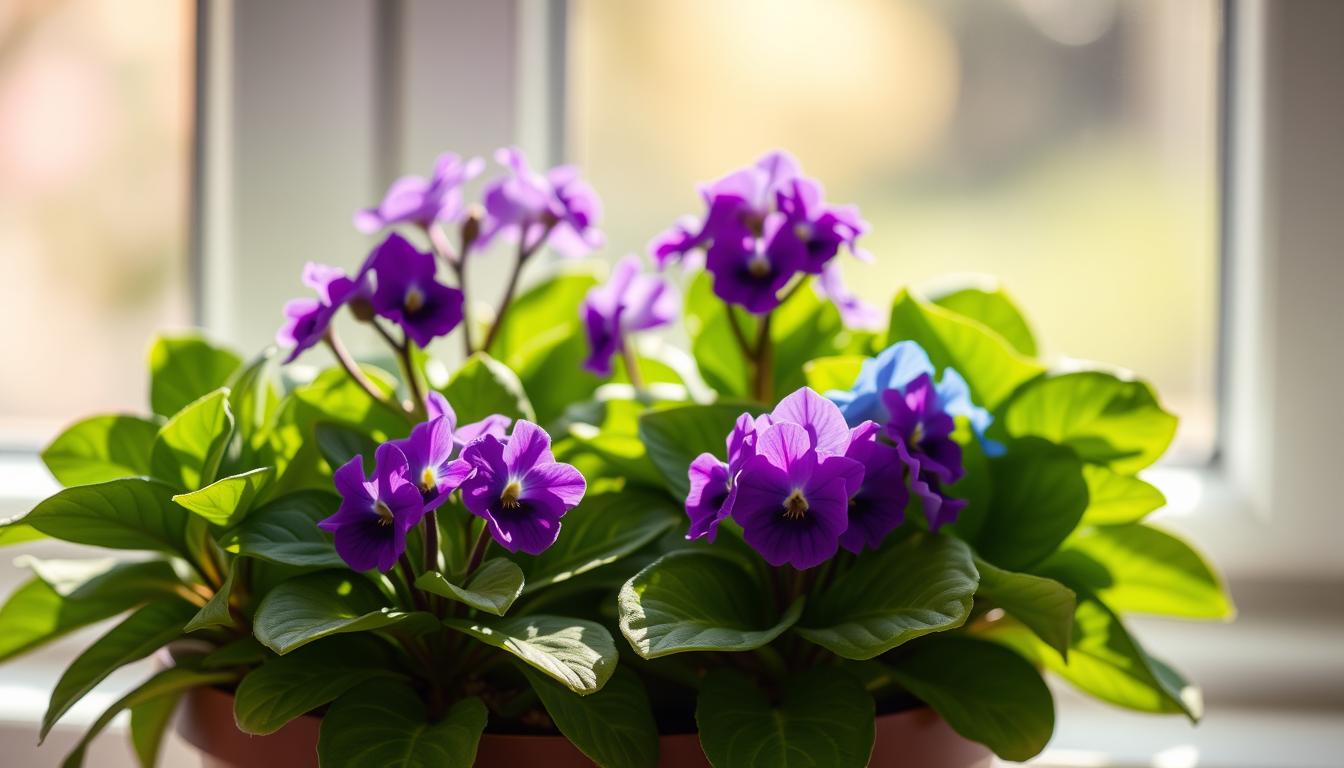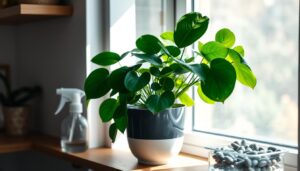Houseplants don’t have to be green. If you want color, fragrance, and beauty at home, try African Violets. These plants brighten your space and add life and energy indoors.
African Violets bloom all year with the right care, says The Spruce. They’re small and can grow well in many places. They’re a top pick for indoor plant lovers.
There are over 2,500 bromeliad species and thousands of hybrids. You can find the perfect plant for your home. African Violets are easy to care for and add beauty to your space.
Introduction to African Violets
African violets are a favorite for indoor gardens. They bloom all year with the right care. First, let’s learn about these plants and their history.
They were found in Africa in 1892. Now, they’re loved as houseplants. Their colorful flowers bloom well in low light, making them great for indoor spaces.
To grow African violets, remember a few things. They need a potting mix that drains well and a weak fertilizer. They also need the right light, at least 8 to 10 inches from fluorescent tubes. Follow these tips to enjoy their beauty at home.
What Are African Violets?
African violets are flowering plants in the Gesneriaceae family. They have small, delicate flowers and grow well in low light. With care, they can live up to 50 years and bloom all year.
A Brief History of African Violets
African violets were first found in Africa in 1892. They came to the US in 1894. The fluorescent light bulb in 1938 made them even more popular.
Why Choose African Violets as Houseplants?
African violets are easy to care for and grow well in low light. They also clean the air and make rooms look better. Their long life and beautiful flowers make them a wonderful choice for homes.
Types of African Violets
African violets are loved for their beauty and variety. They come in over 31 different types. This makes them perfect for anyone who loves plants.
These plants can be big or small. They can grow up to 16 inches or less than 3 inches. They also have different flower shapes and sizes.
Some popular types include Aroma of Summer and Cherry Princess. They have unique colors and shapes. Knowing about these types helps you pick the best plant for your home.
Think about how much space you have and how much light it gets. African violets need the right care to bloom a lot. Learning about them can make you a great plant lover.
| Size Class | Diameter |
|---|---|
| Large | 12 to 16 inches |
| Standard | 8 to 12 inches |
| Semi-miniature | 6 to 8 inches |
| Miniature | 3 to 6 inches |
| Micro-miniature | Less than 3 inches |
Care Essentials for African Violets
To keep your African Violets happy, follow some key steps. A good plant care guide will show you what your plants need. This includes the right soil mix and how to balance light, water, and nutrients.
A good soil mix for African Violets is peat, perlite, and vermiculite. Mix them in equal parts. The pH should be between 6.0 and 7.0. This mix gives your plants the nutrients they need to grow well. It’s also important to keep the soil just right, not too wet.
Understanding Light Needs
African Violets need bright, indirect light to grow and bloom. A south-facing window or fluorescent lights work well. But, direct sunlight can hurt them. Use a sheer curtain or shade to filter the light.
Watering Tips for Healthy Growth
Watering your African Violets needs care. The soil should be moist but not wet. Wait until the top inch of soil is dry before watering again. Don’t get water on the leaves to avoid crown rot. Watering from the bottom can help avoid too much water.
Soil Requirements for Best Results
African Violets like a soil mix that drains well and is rich in organic matter. A mix of peat, perlite, and vermiculite is best. Also, repot your African Violets every 1-2 years. This refreshes the soil and may be needed for a bigger pot. By following these steps and using the right soil, you’ll grow healthy African Violets.
Fertilizing Your African Violets
Exploring African Violets shows fertilizing is key. A good plant care guide stresses the need for nutrients. This helps your plants grow well and bloom.
Start with a fertilizer that has equal parts nitrogen, phosphorus, and potassium. A 14-12-14 ratio is best for African Violets. Fertilize every 4 to 6 weeks in the spring. This keeps your plants healthy and blooming.
Here are some growing tips for fertilizing your African Violets:
- Use a balanced fertilizer with a 14-12-14 N-P-K ratio
- Fertilize every 4 to 6 weeks during the growing season
- Allow municipal water to sit for 24 hours before using it to reduce chlorine toxicity
By using these growing tips and a good plant care guide, you’ll get better at caring for African Violets. Always think about what your plants need and adjust your fertilizing schedule.

For more tips on African Violet care, talk to gardening experts. Also, check out online forums and plant care guide websites.
| Fertilizer Ratio | Feeding Frequency | Waiting Period for Municipal Water |
|---|---|---|
| 14-12-14 N-P-K | Every 4 to 6 weeks | 24 hours |
Propagating African Violets
African violets can be easily grown from leaf cuttings. This is a favorite way for many gardeners. Cut a healthy leaf from the plant and put it in water or soil. A new plant can grow in just four to five weeks.
For the best chance of success, keep the soil moist and the area light. These are important growing tips.
The best time to start is in spring and summer. These months have warmer weather and more light. Also, watch the soil moisture closely. Use a mist bottle to help with this.
Here are some key things to remember when growing African violets:
- Use a healthy leaf cutting from the mother plant
- Provide consistent moisture and adequate light
- Monitor soil moisture and control watering effectively
- Keep the new plant near the mother plant to ensure it receives adequate light
By following these tips and using the right propagation methods, you can grow your African violets successfully. They will bloom beautifully all year. Always follow a plant care guide for the best care. And don’t be afraid to try new growing tips to help them grow even better.
| Propagation Method | Time to Root | Success Rate |
|---|---|---|
| Leaf Cutting | 3-4 weeks | High |
| Seed | 6-12 months | Low-Moderate |
Pests and Diseases in African Violets
African violets are easy to care for but can get pests and diseases. Knowing how to spot and treat these issues is key. Pests like cyclamen mites and mealybugs can harm leaves and flowers. They can even kill the plant if not treated.
Check your plants often to catch problems early. Keep them in a well-ventilated spot. Avoid too much water to prevent root rot. These steps help your African violets stay healthy and bloom beautifully.
Diseases like botrytis blight, powdery mildew, and root rot can hit African violets. They often come from too much water, bad air, and high humidity. Keep plants apart and don’t touch sick ones to stop disease spread. Simple steps can keep your plants blooming for years.

For more tips on caring for African violets, check a good plant care guide. With the right care, your plants will bloom for months.
Decorative Uses for African Violets
African Violets are not just pretty indoor plants. They also make great decorations for your home. As a flowering houseplant, they bring elegance and color to any room.
One way to show off African Violets is by grouping them together. Use small pots and planters to make a unique display. For example, mix African Violets with ferns and Baby’s Tears for a lush look.
Here are some ideas for decorative uses of African Violets:
- Use them as a centerpiece for your dining table
- Create a beautiful arrangement with multiple plants and planters
- Give them as a gift to fellow plant lovers
African Violets are also great in dish gardens. These are small, self-contained gardens in shallow containers. They’re perfect for indoor plants like African Violets, and can be filled with various plants and decorative rocks.
| Plant | Description |
|---|---|
| African Violets | Small, flowering plants perfect for indoor gardens |
| Ferns | Delicate, green plants that add texture and color to arrangements |
| Baby’s Tears | Small, creeping plants with round leaves and delicate white flowers |
African Violets are perfect for any decorative uses. They’re great for creating stunning displays or as gifts. They add elegance and beauty to any room.
Environmental Benefits of African Violets
African Violets are not just pretty. They also help the environment. They clean the air in your home. This is because they use photosynthesis to take in carbon dioxide and make oxygen.
They also remove harmful stuff like formaldehyde and benzene from the air. These are bad things found in many homes.
The NASA Clean Air Study says African Violets are good at cleaning the air. They are perfect for homes, especially for people with breathing problems or stress. Having African Violets means you get cleaner air and a healthier home.
Some big air purification benefits of African Violets are:
- They take in carbon dioxide and make oxygen.
- They remove toxins like formaldehyde and benzene.
- They make the air in your home better.
African Violets are a smart choice for anyone wanting a greener home. They are not only beautiful but also clean the air. They are a wonderful addition to any room.
Troubleshooting Common Issues
When you care for African Violets, you might face some common problems. A good plant care guide can help you find and fix these issues. Knowing how to troubleshoot is key to keeping your plants healthy.
Some common issues include discolored leaves, no blooms, and slow growth. Overwatering is a big problem, causing about 70% of issues. It can make leaves wilt and rot. Underwatering makes leaves droop when the soil is too dry.
To solve these problems, use a troubleshooting guide. Here are some tips for your African Violets:
- Check the soil moisture: Make sure the soil is not too wet or too dry.
- Adjust the watering schedule: Water your plants when the soil feels dry to the touch.
- Provide adequate light: African Violets need bright, indirect light to thrive.
By following these tips, you can keep your African Violets healthy. Always check a plant care guide for more advice on troubleshooting and caring for your plants.
| Common Issue | Cause | Solution |
|---|---|---|
| Discolored leaves | Overwatering or underwatering | Adjust watering schedule |
| Lack of blooming | Insufficient light or nutrients | Provide adequate light and fertilize regularly |
| Slowed growth | Poor soil quality or inadequate nutrients | Improve soil quality and fertilize regularly |
Conclusion: Embracing African Violets in Your Home
African Violets are amazing indoor plants. They add color and life to any room. They bloom all year and come in many varieties.
Take good care of your African Violets. They need the right light, water, and food. Then, they’ll show you beautiful flowers all the time.
Let African Violets make your home beautiful. They can turn any room into a peaceful place. You can show them off alone or in creative flower displays. They will make you happy and inspired.
If you would like to see other Stunning Large Indoor Plants for Decor check out our article of 10 Stunning Large Indoor Plants for Statement Decor.




Pingback: 8 Stunning Flowering Indoor Plants to Brighten Your Home - Trusted House Plant Guide
Pingback: The Ultimate Guide to Houseplants: 100 Best Indoor Plants for Every Home - Trusted House Plant Guide